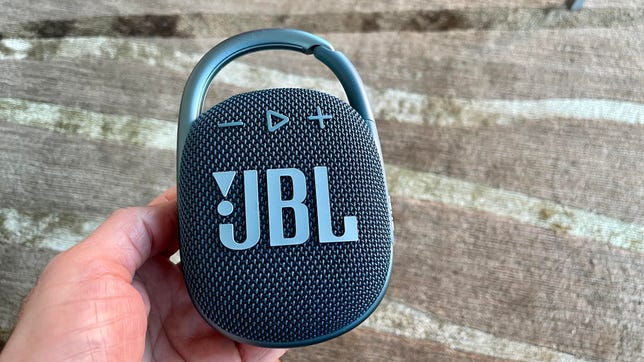JBL Clip 4 Bluetooth speaker review: A new design and improved sound quality
One of our favorite micro Bluetooth speakers is back, and it's changed (mostly) for the good.
Pros
- Compact speaker with impressive sound for its small size
- IPX 67 water-resistance (waterproof and dustproof)
- Up to 10 hours of battery life
- Charges via USB-C
- Integrated carabiner clip is more durable
Cons
- Could cost a little less
- No speakerphone capabilities
For its first three generations, JBL's Clip micro Bluetooth speaker had a circular design. But for the fourth-gen Clip 4, JBL has moved to a more oval shape and bulked up the speaker slightly. It's a tad heavier at 0.24 kilograms (0.53 pounds) vs. 0.22 kilograms (0.49 pounds) for the Clip 3. But it does seem more durable, with a sturdier integrated carabiner "clip." It also sounds better, with more volume, clearer sound and more bass.
It's not a big bump in performance, but the overall package feels like an upgrade over the Clip 3, which remains available. Both list for $70, which converts to about £50 or AU$90. That's a little expensive, but expect to see discounts on both models over the course of the year. (I'd suggest holding out for $50 or less -- note that the Clip 3 occasionally drops to as low as $30.)
Read more: Best portable Bluetooth speakers for 2021
Available in multiple color options, the speaker is designed to play in either a vertical or horizontal position, although it has to be clipped onto something or propped up to be used in a vertical position. Its backside has a set of rubber ribs, so if you lay the speaker on a smooth surface, it won't move around. At higher volumes, the bass does make the speaker vibrate, so you can see why the rubberized back is necessary.
The Clip 4 has USB-C charging and its underside is rubberized so the speaker doesn't move around when you lay it down on a smooth surface.
Like its predecessor, the Clip 4 puts out more volume and better sound than you'd expect, though it does have its limitations. The bass is adequate and the speaker can sound decent with less demanding tracks (these little speakers tend to excel with acoustical material because they're strong in the midrange). It also works well for supplying richer sound for movie playback than what your phone or tablet speakers are capable of.
As always, there are caveats. Most importantly, don't expect the bass to have any serious kick to it: The speaker can end up sounding harsh at top volume (50% to 75% volume levels are optimal, with buttons on the speaker for controlling volume and track playback). In my listening tests, performance varied from track to track. While the X Ambassadors Boom track sounded punchier than I thought it would, for instance, Major Lazer's Know No Better sounded restrained. In short, this small speaker plays above its size class but there's no getting around that it's a small speaker.
Competing products include the Bose SoundLink Micro at $99 (sometimes it goes on sale for $79), the Tribit Stormbox Micro at around $40 (it's our value pick in the micro Bluetooth speaker category) and JBL's own Go3 at $40. All these speakers offer similar sound with small differences. The Bose has more bass and I've always liked its design, but it's also pricier and due for an upgrade as it came out a few years ago. Meanwhile, the Stormbox Micro can match the Clip 4's sound -- and you can link two of them to create a stereo pair -- but the Clip 4's design is arguably superior.
JBL Clip 4 (left) is slightly bigger than the Go 3 (right).
The JBL Go 3 may, in fact, be the better pick. The Clip 4 is louder and has better clarity and bass, but the Go 3 costs $30 less and some people may prefer its design. It's a tad smaller and lighter than the Clip 4, and while it doesn't have an integrated carabiner, it does have a rope loop, so you can attach a carabiner to it.
I also like the Go 3's rectangular design, which can be stood up on its side or laid flat (it's rubberized on the bottom and its side). Its only downside is that its battery life is rated at 5 hours compared to 10 hours for the Clip 4. Your mileage will vary according to your volume levels, so note that battery life ratings are based on playing audio at 50% volume. Don't expect to get anywhere near 10 hours if you crank your tunes.
Clipped to a backpack.
Neither the Go 3 or Clip 4 has speakerphone capabilities or pairs with a companion JBL app (the Clip 3 has a built-in microphone for speakerphone calls), so you can't link up multiple speakers in "PartyBoost" mode like you can with some of JBL's step-up Bluetooth speakers such as the Flip 5 and Charge 4. Neither is a big deal at this price, but you shouldn't go in without knowing that.
Also worth mentioning: The Clip 4 uses upgraded Bluetooth 5.1 while the Clip 3 uses Bluetooth 4.1. Additionally, the Clip 4 isn't fully waterproof like the Clip 3. However, it is dustproof and its IPX 67 water-resistance rating allows it to resist heavy sprays of water.
JBL Clip 4: Final thoughts
JBL Clip speakers have always been easy to recommend because they deliver decent sound for their tiny sizes and their "clip" design makes them easy to attach to a backpack and carry around with you. The same is true for the Clip 4, which has a nicely upgraded design and slightly better sound than its predecessor. I'd be raving about it more if it cost a little less and if JBL hadn't improved the less expensive Go 3 as much as it did.


